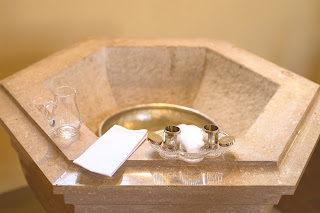Teaching Sermon: Baptismal Beliefs & Practices
As part of our ongoing series of teaching sermons, today we will be exploring baptismal beliefs and practices.
Baptism is a ritual welcome into Christ’s Church. It involves making certain promises and affirmations of faith, a ritual washing, and being marked as Christ’s own forever. It is a sacrament that is almost universally recognized across the many, varied branches of the Jesus Movement. In the fifth century, St. Augustine defined a sacrament as, “an outward and visible sign of an inward and invisible grace.” 1 Depending on who you’re talking to there are two, seven, or even countless sacraments - but we’ll save that thread for another day.
John the Baptist, as his name would suggest, popularized the ritual cleansing of baptism, as a means of reorienting hearts, souls, and minds towards God. People would travel from all over in order to be baptized by him. Yet John was clear with his followers, “I baptize you with water for repentance, but one who is more powerful than I is coming after me; I am not worthy to carry his sandals. He will baptize you with the Holy Spirit and fire.” 2
When John baptized Jesus, the Spirit of God descended on him like a dove, proclaiming Jesus as God’s own.3 The ritual of baptism was adopted by Jesus, and in turn, the early Church, which you can read about in the Book of Acts. Baptism shifted into a ritual that required an extensive, three year period of study and preparation, which would culminate in baptism at the first cockcrow on Easter morning. 4 Immediately afterward, the newly baptized would partake in the Easter Eucharist for the first time. 4
Initially, bishops presided at baptisms. The establishment of Christianity by Constantine brought with it an increased emphasis on the idea of original sin, which needed to be washed away in baptism. 4 This created a sense of urgency, which led to infants and children being baptized, greatly reducing the preparation period. It became impractical for bishops to preside at so many liturgies, and soon priests predominately presided at baptisms. 4 & 5 It is worth noting that in potential life and death situations, baptism does not even require clergy. Any lay person can take water and baptize the one who wants to be baptized.
Baptism has come to symbolize a great deal:
- it is our entry into the universal Church;
- it represents our unity with Christ in this life and in resurrection life;
- it is a reminder of God’s forgiveness;
- and it is an affirmation of the Holy Spirit’s place amongst us and within us, to guide and sustain us in community.
Unfortunately, throughout the Church’s history, there has been some truly unfortunate, and harmful theology around baptism. In particular, teachings about what happens if someone should die without being baptized. I can’t tell you how many conversations Molly and I have had with folks over the years, who are anxious that a loved one, often a grandchild, is not baptized. A fear has been instilled by the institutional Church over the course of centuries, that should a child not be baptized, they would not get to experience resurrection life. This teaching stems from fear, and church leaders using fear to ‘grow the church’. These are the very behaviors and teachings that have left generations of folks questioning and rejecting the institutional Church. Every institution has its shadow side, and that is part of ours; it does not reflect what we know about God’s nature throughout scripture.
Scripture shows us repeatedly that our God is a God of transformative, unconditional love. Whether one has formally been marked in baptism, each and every person in this world is adopted, cherished, and loved by God. It can be hard to remember - about ourselves and others - but we are each beloved, beautiful, and broken children of God. There is a place for all of us at God’s Table. No exceptions. Baptism is not something one should do out of fear - fear of hell or heaven, fear of being outside the hands of God, fear of being left out of a community. Baptism at its best is an intentional act of love, a choice to walk this life with a community. A choice made in freedom, not to avoid an eternal ‘timeout’.
The only real requirement for baptism is a desire to be baptized. A desire to be part of this universal Church that spans across time and space, and a desire to proclaim your intention to the world in thought, word, and deed: I want to walk through this life with faith, hope, and love; to be a part of the movement that will help God’s dream for this world come into fruition; trusting in the knowledge that we are all children of God.
In the Episcopal branch of the Jesus Movement, people of all ages can be baptized. When infants and young children are baptized, it is their parents and sponsors who are making these promises on their behalf, committing to raise the child in faith. Then when they have grown up and become young adults, they can decide whether or not to choose this path for themselves in a confirmation liturgy.
Once upon a time, it was common for baptisms to take place in private, outside of Sunday worship. I am know many of us, myself included, were baptized privately. Then, in the 1979 Book of Common Prayer, the Episcopal Church shifted our theology of baptism to more closely reflect Jesus’ original intent; moving baptism into the context of communal worship. Lauren Winner, in Girl Meets God, emphasizes the importance of baptism taking place in the context of community.
She writes:
“The very point [of baptism] is that no baptismal candidate, even an adult, can promise to do those things all by [themselves]. The community is promising for you, with you, on your behalf…When a baby is baptized, we cannot labor under the atomizing illusion that individuals in Christ can or should go this road alone. When a baby is baptized we are struck unavoidably with the fact that this is a community covenant, a community relationship, that these are communal promises.” 6
The promises we make in our baptism are big, bold, and beautiful ideals for us to strive to live into. The only way we can really live into them is in the context of community, and by remembering the words we say when making these promises: I will, with God’s help. 7 Not I will (period); but, I will (comma) with God’s help - which includes the help of our community.
Let’s take a brief walk through the baptismal liturgy. 7 It begins after the sermon, when the candidate and their sponsors are invited to come forward. The liturgy begins by the candidate affirming it is their desire to be baptized, and the sponsors affirming they will do their best to support this person in their spiritual journey. Then the candidate answers three questions that are focused on turning away from Satan, a name that represents the power of evil in our world and the sinful desires that can separate us from God. After renouncing these powers, the candidate then answers three questions affirming they will put their trust in Jesus Christ, our Savior and guide.
The presider then turns to the congregation and asks the community: Will you as a community do everything in your power to support this person in faith?
We respond with a very loud: We will!
But, this isn’t like signing up to help with the next church fundraiser. This is a community promise to walk beside, care for, and support this person in their spiritual journey. It’s answering the phone when our fellow community member is going through a tough time; it’s being surrogate aunts, uncles, and grandparents to the children and teenagers of this community; it’s sitting at the bedside of a dying church friend. While we are here to transform the world by the power of God’s love, it all begins in our weekly, community worship. We are grounded in that community worship, before going out into the world each Sunday to walk in love. This is not a promise to be taken lightly.
At this point in the liturgy, we are now all standing together, as we are able, as a sign and symbol that we are in this together, both as a local parish and as the universal Church. Together, the soon to be newly baptized and the community affirm the promises of our baptism. Over the course of our lives, we will repeat these promises hundreds of times, and we will never cease to need that reminder of who we are and how we have promised to live.
The Baptismal Covenant takes the shape of question and answer. We begin by affirming the Apostles’ Creed, which has been associated with baptism since the early Church. Each of these three statements begins, I believe. In this instance, I believe, does not mean we are intellectually subscribing to an idea; rather it means, ‘I give my entire heart to this reality’. 6. The creed summarizes the basic teachings of our faith: that God created everything; that Jesus Christ lived; our faith in the Spirit, the universal Church, the communion of saints, that our sins are forgiven, and the promise of eternal life.
We then make six promises:
- to partake in community life, in the eucharist and worship, in fellowship, and in prayer;
- to do our best to resist the power of evil in this world, and when we do lose our way, to repent and turn back to God;
- to live out our faith and share God’s love in thought, word, and deed;
- to see Christ in everyone, and live a life of love and service;
- to engage in the ongoing work of justice and peace; and to respect God’s image within each person;
- and lastly, a new promise was added at the last General Convention, that we will be caretakers of God’s creation.
Then the presider offers prayers of thanksgiving over the water. As Marion J. Hatchett, writes in his Commentary on the American Prayer Book, the water of baptism recalls: “...the waters of creation, the exodus, and the baptism of Jesus in the Jordan River, and portrays the font, in the classical manner as a bath, a womb, and a tomb…”. 4 This is followed by the baptism, which means ‘dip’; as baptism was often a full immersion experience, dunking the candidate three times. 4. Full immersion baptism still happens all the time, though in our tradition we tend to have more folks opt for a small bit of water poured over their head three times.
One Easter in seminary, our parish priest brought a cow trough into the front of the church for a full immersion baptism, well decorated with linen and surrounded by easter flowers. It was beautiful to watch the candidate be dunked in their white robe, but some of the longtime Episcopalians had a bit of a kanipshin that there was a cow trough in their sanctuary. I haven’t done this to you yet - but no promises.
As the water is poured out, the presider says, “...I baptize you in the Name of the Father, and of the Son, and of the Holy Spirit. Amen.” 7. This baptismal formula comes from the Great Commission in Matthew: “Go therefore and make disciples of all nations, baptizing them in the name of the Father, and of the Son, and of the Holy Spirit.” 8
Following the baptism, a prayer is said thanking God for what has just happened, and asking the Spirit to sustain and nurture them. The presider then takes an oil of thanksgiving blessed by the bishop, known as chrism oil, and says, “...you are sealed by the Holy Spirit in Baptism and marked as Christ's own for ever. Amen.” 4 & 8 Then the newly baptized is welcomed into the household of God.
This has been a mere cursory glance at baptismal belief and practices. There is much that was not covered, and if you're interested in learning more, please speak to Molly or myself.
As we prepare for a baptism next Sunday, I would invite us all to do some reflecting this week:
- Are you baptized? If so, what do you remember about your baptism? Or, if you were too young to remember, what does it mean to you that your loved ones chose this path for you?
- If you're not yet baptized, are you interested in being baptized? What would it mean to you?
- What part of the baptismal liturgy means the most to you and why?
- What does it mean to you that the promises of baptism are communal promises?
- https://www.episcopalchurch.org/glossary/sacraments/
- Matthew 3:11 NRSVA
- Matthew 3: 16-17 NRSVA
- Commentary on the American Prayer Book by Marion J. Hatchett, pages in order of reference: 253, 256, 255, 256, 275, 274, 253.
- Walk in Love: Episcopal Beliefs & Practices by Scott Gunn & Melody Wilson Shobe, pages in order of reference: 29, 23-24, 24,
- Girl Meets God: A Memoir by Lauren Winner, pages in order of reference: 80, 268.
- The 1979 Book of Common Prayer, pages in order of reference: 302, 301, 308, 307, 308,
- Matthew 28:19 NRSV
As preached at the Episcopal Church of Saints James and Andrew, Greenfield, MA




Comments
Post a Comment